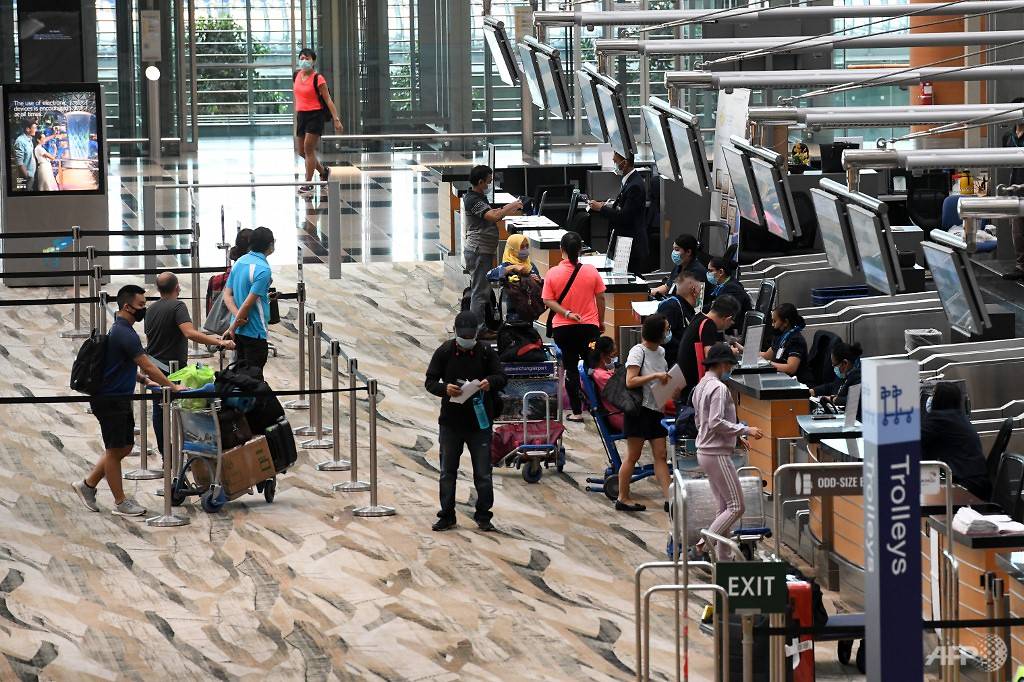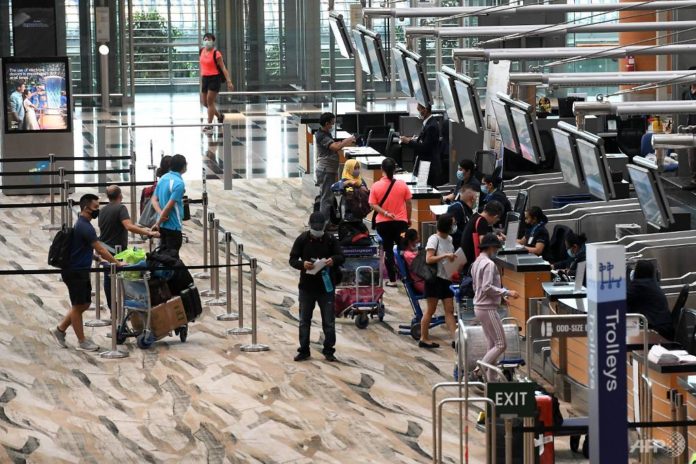SINGAPORE: Pursuing more green lane arrangements and negotiating air travel bubbles with countries whose COVID-19 infection rates are low were among the plans outlined by Transport Minister Ong Ye Kung on Tuesday (Oct 6) to “revive” Changi Air Hub.
Mr Ong delivered a ministerial statement in Parliament on the Government’s strategies for the aviation sector, which has been hit hard by the COVID-19 pandemic.
Taking “proactive steps” to revive Changi Air Hub is a “top national priority”, said Mr Ong.
However, he pointed out that there was a need to “manage expectations”.
“I need to manage expectations here. For members who are hoping that I’m about to announce some air travel resumption and even possible December holiday destinations, I am sorry I will disappoint you,” he said.
“The key is to make sure we stay safe and manage the risks. We have gone through quite a bit, including a painful circuit breaker, to arrive at the stable situation we have today. And we must not give that up.”
READ: COVID-19: Rigorous testing could help revive travel but challenges remain, say experts
Mr Ong added that COVID-19 testing capacity is no longer a “major constraint”, with Singapore “on track” to increase testing capacity to 40,000 tests a day by November. Currently, about 27,000 people in Singapore are tested daily, he said.
Changi Airport has already set up a facility to swab up to 10,000 passengers a day. In the next few months, there are plans to set up a dedicated COVID-19 testing laboratory at the airport to support aviation recovery, said Mr Ong.
“Testing is therefore the key to unlock air travel. With COVID-19 around for a while, the emerging international practice is to get tested before travel, not different from us going through security, having our bags checked, before we board a plane,” said Mr Ong.
MORE GREEN LANES FOR BUSINESS TRAVELLERS
Singapore will continue to pursue reciprocal green lane arrangements with partner countries or regions, said Mr Ong.
These are restricted to a small group of essential business and official travellers, who will be subjected to pre-departure and on-arrival COVID-19 tests to ensure that they do not carry the virus.
These travellers will also have “controlled itineraries” to minimise any residual risk of community spread, the minister said.
Currently, Singapore has such arrangements with Brunei, China, Japan, Malaysia, and South Korea.
READ: Singapore and Japan launch ‘green lane’ for business, official travel on Sep 18
Singapore will also continue to facilitate passenger transfers at Changi Airport, said Mr Ong.
“As an air hub, about a quarter of our passenger volume at Changi are transfers, meaning the passengers do not clear immigration and are using Changi Airport as an interchange to get to their final destinations,” he explained.
“On a weekly basis, we are now serving about 2,500 transfer passengers, and we expect the numbers to rise steadily. But this is still a small fraction of what we used to serve. We have put in place robust safeguards and no Singaporean has become ill as a result of these transfers.”
Since June, about 27,000 passengers have transferred safely through Singapore, added Mr Ong, in response to a question from Ang Mo Kio GRC Member of Parliament (MP) Gan Thiam Poh.
UNILATERAL REOPENINGS ARE A “STANDING INVITATION”
Singapore also should be prepared to lift border restrictions to countries and regions with “comprehensive public health surveillance systems”, and comparable incidence rates to Singapore, said Mr Ong.
“We already know who they are. And at the same time, we should also lift our travel advisory for Singapore residents travelling to these countries and regions,” he added.
“Purely from an infection risk point of view, the risk of a traveller from these places carrying the virus when they arrive at Changi Airport, is no higher than that of a Singapore resident coming from Jurong or Sembawang, because we are of the same incidence rate, same risk profile. But as a precaution, we will subject these travellers to a COVID-19 test, to ensure they are free from the virus.”
READ: New Zealand aware of Singapore’s intent to establish travel, advisory to residents remains unchanged
The governments of these countries can then decide if and when they want to open their borders to travellers from Singapore, said Mr Ong.
Last month, Singapore opened up unilaterally to travellers from Brunei and New Zealand. A reciprocal green lane with Brunei has since been established.
Singapore also lifted border restrictions for some travellers from Vietnam and Australia, excluding Victoria state.
READ: COVID-19: Singapore to lift border restrictions for some visitors from Australia, Vietnam
“We do not expect big numbers in the short term, because these countries currently discourage or restrict travel for their residents,” he added.
“But notwithstanding this, such unilateral opening is still meaningful, because it is like a standing invitation. Although the other countries are not ready to lift their restrictions now, Singapore can be top of mind when they are ready eventually.”
AIR TRAVEL BUBBLES A POSSIBILITY
Singapore will also negotiate air travel bubbles with safe countries and regions, said Mr Ong.
These air travel bubbles are for general travellers and have no requirements for a “controlled itinerary”. These are different from reciprocal green lanes, which are for official and essential business travel.
“While we should establish (air travel bubbles) only with safe countries and regions, we can further manage risks by setting a quota on the number of travellers per day and ensuring that everyone abides by COVID-19 test protocols,” said Mr Ong.
“We also require travellers to apply for an air travel pass before their journeys, to allow us to plan for their arrivals, and throttle down the numbers, reduce the quota, if the epidemic situation changes.”
Mr Ong noted how Hong Kong has announced its intention to establish such air travel bubbles with several countries, including Singapore. Singapore hopes to commence discussions with Hong Kong and other partners soon, the minister said.

Passengers queue at a check-in counter at Singapore Changi Airport on Jun 8, 2020. (File photo: AFP/Roslan Rahman)
The Ministry of Transport will also explore other “practical schemes” as it seeks to open borders, said Mr Ong.
“This is especially important for travellers from countries which are economically important to us, but with higher infection rates,” the minister said.
“In particular, we recognise that the requirement of having to serve a full 14-day (stay-home notice) in a hotel, will deter most travellers from wanting to come to Singapore. So we have to facilitate the visits without such an onerous restriction,” Mr Ong added.
“For example, we can replace the 14-day (stay-home notice) in a hotel with new requirements, such as a more stringent and repeated test protocol … we can segregate them from the rest of the community … we can closely track their movements while they are here.”
The global aviation sector has been severely crippled by the COVID-19 pandemic with strict border restrictions limiting travel, causing a plunge in revenue and an increase in layoffs by airlines and related businesses.
Singapore Airlines (SIA) Group reported in May the first annual net loss in its 48-year history and has said it will cut about 4,300 positions, affecting around 2,400 staff.
One of the initiatives SIA had considered recently was “a flight to nowhere”, as a way of generating revenue, noted Mr Ong.
While it has since become a “moot point” because SIA decided to scrap the plan, Mr Ong said that the Ministry of Transport would have tried its best to support the airline “whichever way SIA had decided”.
“But what I will not contemplate is to impose on them an environment tax at this time, as Associate Professor Jamus Lim indicated in his question, because that will worsen the crisis for SIA,” said the minister.
READ: Singapore Airlines Group to cut about 4,300 positions as COVID-19 batters aviation industry
Comparing the airport to the “lung of Singapore”, Mr Ong stressed its importance to Singapore’s economic growth.
“Just as a lung takes in oxygen and vitalises every part of the human body, the airport connects Singapore with the outside world, and energises every sector of our economy,” said Mr Ong.
“So when a company puts a significant investment in Singapore, one key reason for them to do that is our superior air connectivity, because that means customers, suppliers, partners, key executives, they can travel in and out of Singapore easily. They can come in from any part of the world, come to Singapore and then connect to another part of the world. Our status as a hub, as an air hub, makes that possible.”
And just as Singapore has opened up following the circuit breaker, it will do the same with international borders, said Mr Ong.
“It will be the same with our international borders, to open up step-by-step, carefully, safely, steadily,” he said.
“What is at stake is not just hundreds of thousands of jobs, but our status as an air hub, Singapore’s relevance to the world, our economic survival, and in turn, the ability to determine our own future.”
BOOKMARK THIS: Our comprehensive coverage of the coronavirus outbreak and its developments
Download our app or subscribe to our Telegram channel for the latest updates on the coronavirus outbreak: https://cna.asia/telegram





